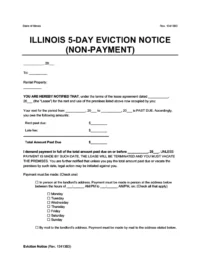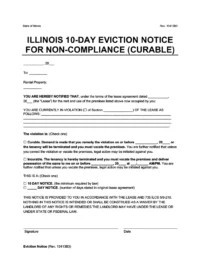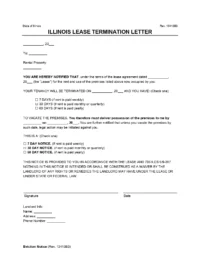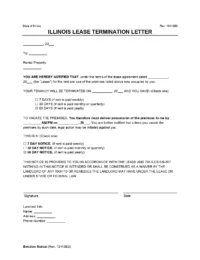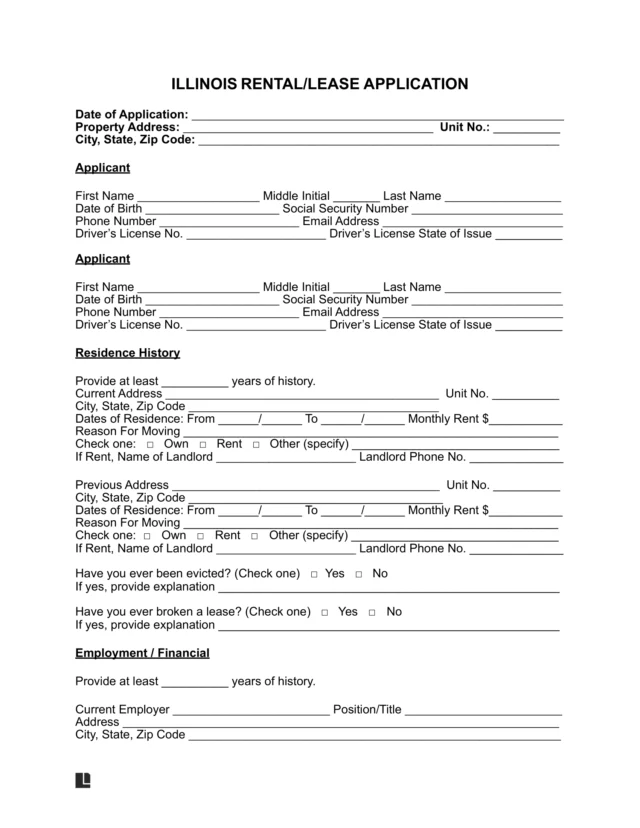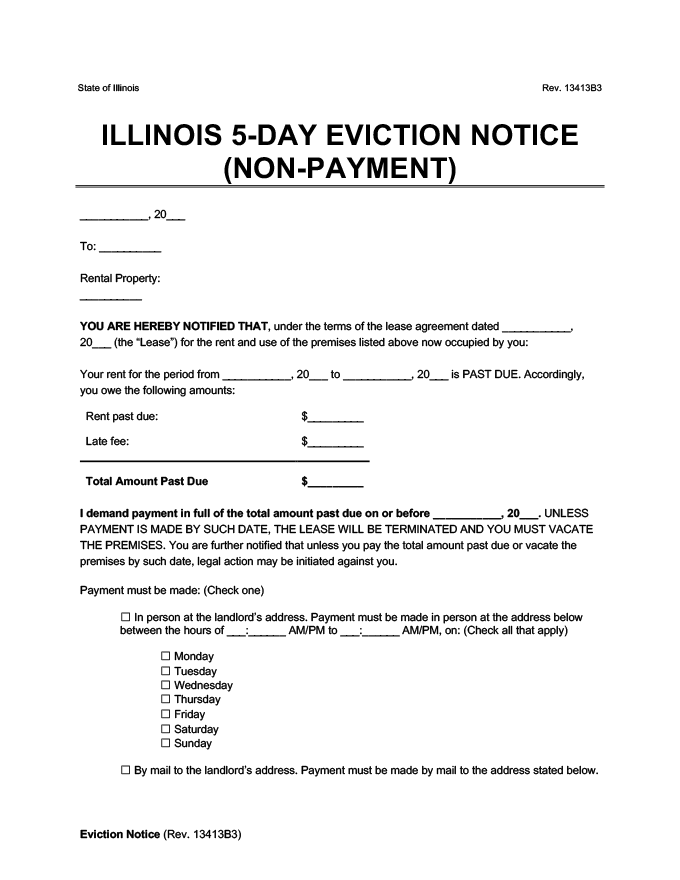Understanding Eviction Notices in Illinois
Under Article IX of the Illinois Code of Civil Procedure (735 ILCS 5/9-101 et seq.), landlords in Illinois must serve tenants with a legally valid eviction notice before filing a formal eviction lawsuit. The notice must include the reason for termination, the tenant’s opportunity to fix the issue (if allowed), and the number of days to comply.
Common notice types include 5-day notices for non-payment of rent, 10-day notices for non-compliance, and up to 60 days for lease terminations, depending on the lease type. All notices must be properly delivered before the court will allow an eviction case to proceed.
Legal Templates’ document builder helps landlords create court-ready eviction notices that follow Illinois law.
Types of Eviction Notices in Illinois
Illinois landlords must choose the correct notice based on the lease type and reason for eviction. Each notice has its own legal time period and delivery requirements under the Illinois Compiled Statutes.
5-Day Notice to Pay Rent or Quit
Illinois landlords must give tenants 5 days to pay overdue rent before beginning eviction proceedings, according to IL Code § 5/9-209. The notice must include the exact amount due and state that the tenancy will terminate if payment isn’t made within 5 days.
5-Day Eviction Notice for Non-Payment
Use this notice to inform tenants of rent arrears and give them five days to pay before termination.
10-Day Notice to Quit for Non-Compliance
For lease violations other than unpaid rent, such as property damage, unauthorized occupants, or illegal activity, landlords may serve a 10-day notice to quit under IL Code § 5/2-210. This does not require the landlord to offer a chance to cure the violation.
10-Day Eviction Notice for Non-Compliance
Use this notice to inform tenants of lease violations, giving ten days to vacate before eviction.
7-Day Lease Termination Notice (Week-to-Week)
To end a week-to-week lease agreement, landlords must serve a 7-day written notice under IL Code § 5/9-207. This termination does not require a lease violation.
7-Day Notice Lease Termination
Use this notice to formally terminate week-to-week lease agreements, ensuring legal compliance.
30-Day Lease Termination Notice (Month-to-Month or Quarter-to-Quarter)
To terminate a month-to-month or quarter-to-quarter tenancy, landlords must provide a 30-day written notice under 735 ILCS 5/9-207. This no-cause termination must be timed properly before the next rental period begins.
30-Day Notice Lease Termination
Use this letter to inform monthly or quarterly tenants of lease termination, requiring 30-day notice before eviction.
60-Day Lease Termination Notice (Year-to-Year)
To end a year-to-year tenancy, Illinois landlords must serve a 60-day notice before the lease renews, as outlined in IL Code § 5/9-207.
60-Day Notice Lease Termination
Use this letter to formally end year-to-year tenancies or notify non-renewal of leases.
How to Evict a Tenant in Illinois
Evictions in Illinois follow a court-supervised process under 735 ILCS 5/9, commonly called the Forcible Entry and Detainer Act. Follow these steps to evict a tenant:
Step 1: Provide Written Notice
To evict a tenant in Illinois, the landlord must first provide written notice to the tenant, which should state the potential reason(s) for eviction based on non-payment of rent, non-compliance, or termination of a month-to-month tenancy.
Step 2: File for Eviction
If the tenant fails to respond by the required time and remains at the premises in breach of the lease, the landlord will file a Forcible Entry and Detainer Action (eviction) with the Local Circuit Court in the county where the property is located.
Step 3: Send Court Summons
The landlord will then provide a filing fee of $234 and three copies of the Complaint and Summons (available through the county court): one for the court clerk, one for their records, and one for the sheriff to serve on the tenant.
In Illinois, electronic filing is the standard method of filing for civil cases. Unless the landlord has received an exemption to file in person, these forms must be e-filed. Forms may be e-filed at the courthouse for anyone who doesn’t have access to a computer.
Step 4: Contact the Sheriff
Once the Complaint and Summons have been filed with the court, the landlord will provide a copy to the sheriff, who will serve the documents on the tenant. The sheriff charges an additional fee of $60 for the service, which the landlord is also responsible for. Once the tenant has been served, they should respond to the landlord’s claims with the Answer form.
Step 5: Attend the Eviction Hearing
The court will then schedule a date for the landlord and tenant to appear. If the tenant doesn’t appear, or if the judge rules in favor of the landlord, the judge will issue an Eviction Order that requires the tenant to move out by a certain date. If the tenant still fails to leave the property, the landlord should give the Eviction Order to the sheriff, who will enforce the order and complete the eviction.
Related Illinois Court Forms
- Eviction Summons: A Summons notifies the tenant that they are being sued and provides them with information on a response deadline and how to plead their case in court.
- Eviction Complaint: An Eviction Complaint begins the eviction process and is filed with the Court to start the case. It is also served on the tenant with the Summons to explain why they are being sued for eviction.
- Answer/Response to Complaint: The tenant responds with this form by the date set in the summons and must agree to or deny the statements made in the complaint.
- Eviction Order: The judge uses this form to grant an eviction order. After the judge grants an eviction, the landlord can take the Eviction Order to the Sheriff’s Department to remove the tenants from the property.

